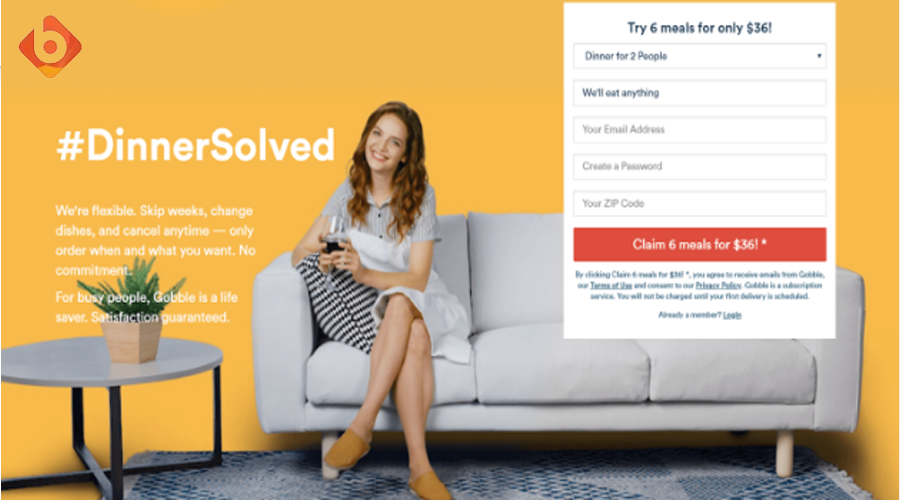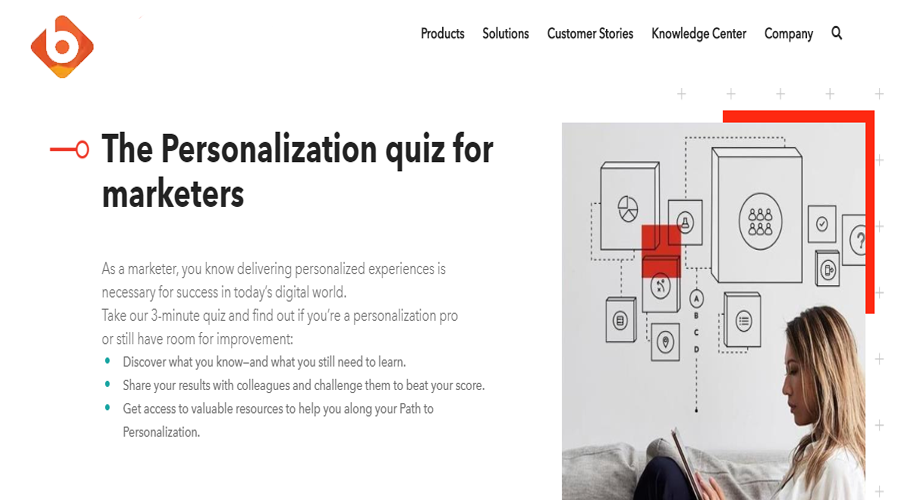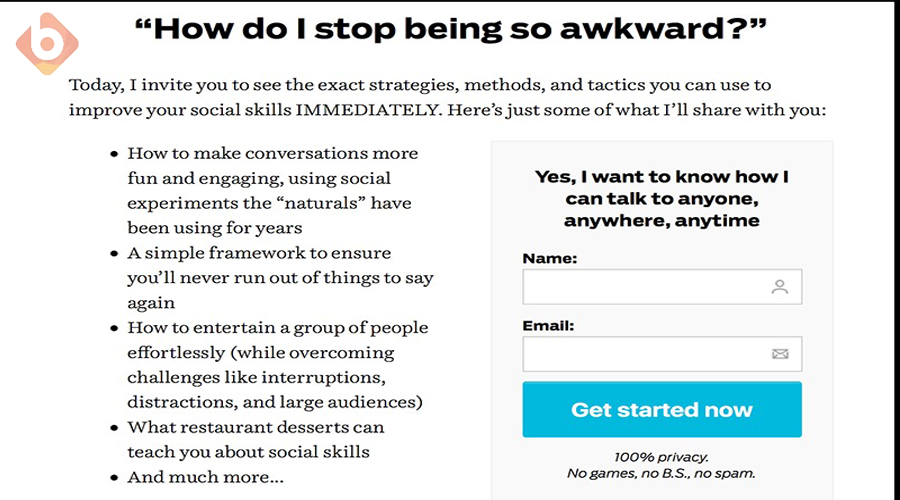In this article, we will explain why asking a question on your landing page can increase your conversions, and how to craft a compelling question that resonates with your audience.
Why Asking a Question Works
Asking a question on your landing page can have several benefits for your conversions. Here are some of them:
- It grabs attention. A question is a powerful way to capture the attention of your visitors and make them curious about your offer. A question can also stand out from the rest of the text and create contrast on your page.
- It engages emotions. A question can trigger an emotional response in your visitors, such as curiosity, interest, excitement, or fear. Emotions are key drivers of human behavior and decision making, and they can motivate your visitors to take action.
- It creates relevance. A question can help you connect with your visitors and show them that you understand their needs, problems, or desires. A question can also help you segment your audience and target them more effectively.
- It stimulates thinking. A question can make your visitors think about your offer and how it can benefit them. A question can also challenge their assumptions or beliefs and create cognitive dissonance, which can lead to persuasion.
- It invites interaction. A question can encourage your visitors to interact with your page and respond to your call to action. A question can also create a dialogue between you and your visitors and build trust and rapport.

How to Craft a Compelling Question
Asking a question on your landing page is not enough to increase your conversions. You need to ask the right question that appeals to your audience and aligns with your offer. Here are some tips on how to craft a compelling question for your landing page:
- Know your audience. Before you write any question, you need to know who you are talking to and what they want. You need to do some research on your target market and create buyer personas that represent their demographics, psychographics, pain points, goals, and motivations.
- Know your offer. You also need to know what you are offering and how it can solve your audience’s problems or fulfill their desires. You need to have a clear value proposition that summarizes the benefits and features of your product or service, and how it differs from your competitors.
- Know your goal. You also need to know what you want your visitors to do after they land on your page. You need to have a clear call to action that tells them what action you want them to take, such as signing up, downloading, buying, or contacting you.
- Make it specific. Your question should be specific enough to address the main problem or desire of your audience, and relate to your offer and goal. A vague or generic question will not capture their attention or interest, and will not persuade them to take action.
- Make it simple. Your question should be simple enough to understand and answer quickly. A complex or confusing question will frustrate or bore your visitors, and will not engage them emotionally or cognitively.
- Make it open-ended. Your question should be open-ended enough to stimulate thinking and curiosity, and invite interaction. A closed-ended question that can be answered with a yes or no will not generate much interest or dialogue, and will not challenge their assumptions or beliefs.
Examples of Landing Pages with Questions
To illustrate how asking a question on your landing page can increase your conversions, here are some examples of landing pages that use this technique effectively:
- Shopify: “Want to sell online? Start here.” This question is specific, simple, open-ended, and relevant to the audience of aspiring online entrepreneurs who want to start an e-commerce business. It also aligns with the offer of a free trial of Shopify’s platform and the goal of getting sign-ups.
- Grammarly: “How strong is your writing?” This question is specific, simple, open-ended, and relevant to the audience of writers who want to improve their writing skills. It also aligns with the offer of a free writing assistant tool and the goal of getting downloads.
- HubSpot: “How do you stack up against other marketers?” This question is specific, simple, open-ended, and relevant to the audience of marketers who want to benchmark their performance and learn best practices. It also aligns with the offer of a free marketing report and the goal of getting leads.

- Maybe you are interested: Content Marketing: A Guide to Maximizing Effectiveness
How to Test Your Landing Page Question
Once you have crafted a compelling question for your landing page, you need to test it to see how it performs. Testing your landing page question can help you measure its impact on your conversions, and optimize it for better results. Here are some steps on how to test your landing page question:
- Set up a landing page tool. You need a tool that allows you to create and test different versions of your landing page, such as Unbounce, Leadpages, or Instapage. These tools can help you design, publish, and track your landing pages easily and quickly.
- Create a control and a variation. You need to create two versions of your landing page: a control and a variation. The control is the original version of your landing page without the question, and the variation is the new version of your landing page with the question. You need to make sure that everything else on the page is identical, except for the question.
- Run an A/B test. You need to run an A/B test to compare the performance of the control and the variation. An A/B test is a method of randomly splitting your traffic between two versions of your landing page, and measuring their conversion rates. You can use your landing page tool or a third-party tool such as Google Optimize, Optimizely, or VWO to run an A/B test.
- Analyze the results. You need to analyze the results of your A/B test to see which version of your landing page has a higher conversion rate. You need to look at the statistical significance of your results, which is a measure of how confident you can be that the difference between the two versions is not due to chance. You can use a calculator such as this one to determine the statistical significance of your results.
- Choose the winner and iterate. You need to choose the winner of your A/B test and implement it on your landing page. If the variation with the question has a higher conversion rate than the control, then you have found a winner. If not, then you need to iterate and try a different question or tweak other elements of your landing page.
- Maybe you are interested: Most Effective Ways To Drive Sales With Social Media
Best Practices for Asking Questions on Your Landing Page
To maximize the effectiveness of asking questions on your landing page, here are some best practices that you should follow:
- Use one question per landing page. You should avoid asking multiple questions on your landing page, as this can confuse or overwhelm your visitors, and dilute the impact of your main question. You should focus on one question that captures the essence of your offer and goal.
- Place your question above the fold. You should place your question above the fold, which is the part of your landing page that is visible without scrolling. This way, you can ensure that your question is seen by most of your visitors, and that it grabs their attention immediately.
- Match your question with your headline. You should match your question with your headline, which is the main text that summarizes your offer and value proposition. Your question and headline should work together to create a clear and compelling message that persuades your visitors to take action.
- Use contrast and whitespace. You should use contrast and whitespace to make your question stand out from the rest of your landing page elements. Contrast is the difference in color, size, or font between two elements, and whitespace is the empty space between elements. By using contrast and whitespace, you can draw attention to your question and make it more readable and noticeable.

Common Mistakes to Avoid When Asking Questions on Your Landing Page
Asking questions on your landing page can be a powerful way to increase your conversions, but it can also backfire if you make some common mistakes. Here are some mistakes that you should avoid when asking questions on your landing page:
- Asking negative questions. You should avoid asking negative questions that imply a problem or a flaw in your visitors, such as “Are you struggling with your finances?” or “Do you hate your job?”. These questions can make your visitors feel bad or defensive, and they can also trigger a negative answer that contradicts your offer or goal. Instead, you should ask positive questions that imply a solution or a benefit for your visitors, such as “How would you like to improve your finances?” or “What if you could love your job?”.
- Asking leading questions. You should also avoid asking leading questions that suggest a specific answer or outcome that you want your visitors to agree with, such as “Don’t you want to save money and time?” or “Isn’t it time to upgrade your skills?”. These questions can make your visitors feel manipulated or pressured, and they can also trigger a rebellious answer that opposes your offer or goal. Instead, you should ask neutral questions that allow your visitors to form their own opinions or preferences, such as “How much money and time do you want to save?” or “What skills do you want to learn?”.
- Asking irrelevant questions. You should also avoid asking irrelevant questions that have nothing to do with your offer or goal, such as “What is your favorite color?” or “How do you like your coffee?”. These questions can make your visitors confused or distracted, and they can also reduce the credibility and authority of your landing page. Instead, you should ask relevant questions that relate to your offer or goal, such as “What kind of design do you want for your website?” or “How do you like to learn new things?”.
Regarding the feedback on the landing page, it appears that the page breaks our "avoid open-end question" rule, but it does so masterfully by demonstrating that any marketing rule should be tested on your own site, under your own conditions. This highlights the importance of experimentation and customization.

Additionally, when it comes to personal (emotional and psychological) problems, using the possessive determiner "My" instead of "Your" can often be more effective. An example of this is when Michael Aagaard switched his call to action to the first-person and experienced a significant 90% increase in click-through rates.
Applying a similar approach, the same trick could be employed in the landing page heading to urge users to stop and read further. This strategy is particularly suitable for businesses in medical, coaching, book selling, and similar fields, where establishing an intimate connection with potential customers is crucial.
Please let me know if you have any further questions or if there's anything else I can assist you with.
Conclusion
Asking a question on your landing page is a simple but effective way to increase your conversions. It can help you grab attention, engage emotions, create relevance, stimulate thinking, and invite interaction. However, you need to ask the right question that appeals to your audience and aligns with your offer and goal. By following the tips and examples in this article, you can craft a compelling question that will boost your landing page conversions.
